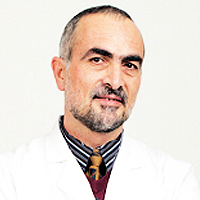ACE2 and TMPRSS2 polymorphisms and the development of COVID-19: a review of the literature
Published on: 28th April, 2022
SARS-CoV-2 is a virus that has a positive-sense, single-stranded RNA genome that encodes 4 structural proteins, the main one being the S protein (Spike) responsible for mediating with ACE2 and TMPRSS2 for entry into the host cell. The study of single nucleotide polymorphisms (SNPs) of ACE2 and TMPRSS2 can elucidate their possible intervention in the action of the protein, its activity, and the gene expression of encoding these enzymes, which may increase susceptibility to viral infection. From this, literature searches were carried out until December 2021, listing 11,820 publications for literary analysis on the described genetic variations of these protein structures, as well as their relation and influence on the pathology. It was possible to conclude that there is a great influence exerted by genetic variability in ACE2 and TMPRSS2 increasing the ability of the virus to bind to the host cell and the development of COVID-19 with complications.
Infection by SARS-CoV-2 in healthcare workers of a second level hospital
Published on: 6th May, 2022
Background: From the first COVID-19 case in Playa del Carmen, 370 cases of infection have been reported in our staff until December 31, 2020. Material and methods: Study in workers of the General Hospital who developed SAR-CoV-2 infection during the pandemic. A sample of 30 cases of both sexes with laboratory-confirmed infection was obtained. Descriptive statistics were used with measures of central tendency, dispersion and percentages. Results: In a sample of 30 workers there were 13 doctors, 6 nurses and 11 support workers. The age was obtained as a mean of 38.8 years and SD = 10.4. Only four risk factors were found. Of the 30 infected health workers, 27 were treated on an outpatient basis and three required hospitalization. Discussion: The main symptoms in health workers are alterations in the sensation of taste and smell, but unlike our study, was headache, fever and myalgia. Likewise, it has been observed that medical are the most affected, but in this study it was support and the least affected was nursing personnel. There is no doubt that asymptomatic carriers are a serious disease transmission problem such that transmission between health workers by asymptomatic carriers is possible as was observed in this analysis.
Face mask utilization and associated factors in combating COVID-19 pandemic among government employee in Akaki district administration offices, Oromia, Ethiopia, 2022
Published on: 10th May, 2022
OCLC Number/Unique Identifier: 9507349192
Background: The novel coronavirus is a rapidly spreading respiratory disease that has been declared a pandemic by the World Health Organization (WHO) and a global public health emergency. The use of face masks has been recommended by the WHO and the Centers for Disease Control (CDC) as a standard prevention method for transmission of COVID-19.Objective: The objective of this study is to determine face mask utilization and associated factors in combating the COVID-19 pandemic among government employees in Akaki district administration offices in Akaki District, Oromia, Ethiopia, 2022Methods: A quantitative cross-sectional study was conducted from December 1, 2021, to February 15, 2022, on 385 government employees working in Akaki district administration offices. After obtaining consent from the study participants, data were collected using pretested, self-administered, and standardized questionnaires adapted from other studies. After the data was collected, it was entered into Epi info version 7.2.6, cleaned, and analyzed using SPSS version 26. A logistic regression model was computed to measure the association between the predictor and outcome variables. A p - value of.05 with a 95% CI was used as the cut-off point to declare the level of statistical significance. Results: The study showed that the magnitude of good practice for facemask utilization was 213 (53.5%) (95% CI: 1.50, 1.60) for preventing COVID-19. In the multivariate logistic regression analysis, the odds of using face masks among male employees (AOR = 0.275; 95% CI: 0.137, 0.555), employees aged 20-29 (AOR = 0.17; 95% CI: 0.065, 0.481 ), employees aged 30-39 (AOR = 0.260, 95% CI: 0.109, 0.623), employees of less than five family size (AOR = 0.549, 95% CI: 0.303, 0.995), work experience at 6-12 (AOR = 0, 32, 95 CI: 0.120, 0.450), poor knowledge about face mask use (AOR = 0.504, 95% CI: 0.302, 0.844), and employees with a negative attitude (AOR = 0.430, 95% CI: 0.256, 0.721) were factors significantly associated with face mask utilization.Conclusion: The magnitude of facemask utilization was low (53.5%) compared to other studies. The results of the study showed that age, sex, household family size, work experience, poor knowledge, and the negative attitude of employees toward facemask utilization were among the factors significantly associated with facemask utilization.
Persistent symptomatic hyponatremia post-COVID 19: case report
Published on: 16th May, 2022
OCLC Number/Unique Identifier: 9524461908
Background: Hyponatremia associated with COVID-19 is considered an independent risk factor for a prolonged hospital stay, intensive care admission, and death, but its causes and treatment are not yet well known. Many workers attribute hyponatremia associated with COVID-19 to acute kidney injury and nephropathy associated with the disease. Others suggest that it is related to the syndrome of inappropriate antidiuretic hormone secretion, sepsis, or hypothalamic-pituitary dysfunction. We report a case of persistent acute hyponatremia in a COVID-19 patient with multifactorial etiology. Case presentation: A managed 77 years with known hypertension, type II DM, ischemic heart disease, chronic kidney disease (stage 3B and on treatment) presented with post-COVID-19 pneumonia, confusion, fever, generalized fatigability, dizziness, and lower limb edema. COVID-19 ad has been diagnosed two weeks earlier with a positive nasopharyngeal swab and was managed with dexamethasone, 10 mg oral for 10 days, azithromycin, 500 mg once orally, and levofloxacin, 500 mg once orally. At presentation, laboratory investigation showed hyponatremia (127.7 mg/dl). Conclusion: The etiology of hyponatremia associated with COVID-19 is different from that in other cases of hyponatremia and its management should be individualized according to patient history and clinical assessment, and effort is needed to determine the exact cause.
Clinical profile, etiology, outcome and new-onset diabetes: A SARI case series
Published on: 28th June, 2022
Introduction: The world is currently facing the SARS-CoV-2 pandemic with evolving 2nd wave. The COVID-19 patients present most commonly with Severe Acute Respiratory Illness (SARI) in an emergency room with acute onset fever, cough, and breathlessness. However, not all SARI cases as per definition are due to COVID-19 infection, which is well proven in this case series of 113 cases of SARI. This is just the opposite of the other SARI series done in the pre-COVID-19 era. Also, no previous SARI case series data has shown significant association with Diabetes Mellitus, including new-onset diabetes thus figuring out the major Pathophysiological association of COVID-19 with glucose metabolism and has a bearing on the pathogenesis, treatment, and outcome of COVID-19 infection and perpetuity of pandemic of this magnitude. Here we raise concern for the first time about the growing association of an infectious pandemic with the lifestyle disorders which are non-communicable diseases but carry with them the potential of fertile soil for rapidly spreading epidemics.Aim and objective: To find out the etiology, clinical profile, treatment outcome, and mortality rate in different sub-groups of SARI cases in a tertiary care hospital and the incidence of new-onset Diabetes Mellitus in them and to investigate theoretically the hypothesis that maintaining normal glucose metabolism could prevent progression of a mild Flu-like illness (FLI) to a severe form of Severe Acute Respiratory Illness (SARI) and consequent complications such as Cytokine Storm Syndrome and Multi-Organ failure.Design: Retrospective, single-center case series of 113 SARI patients at a tertiary care hospital in Agra India between 1 March- 30 October 2020.Main outcome: The demographics, clinical, pathological, imaging, and treatment outcome data were collected. The SARI cases analyzed were defined as “Severe acute respiratory infections (SARIs) an acute respiratory illness of recent onset (within seven days) manifested by fever (≥38°C), cough and shortness of breath or difficulty in breathing requiring hospitalization and were sub-classified according to the primary etiology producing SARI in them. The findings were compiled and compared. Conclusion: Of the 113 patients of SARI – 32.7 %were associated with Diabetes, with 9.74% new-onset Diabetes and 26 % previously known Diabetes. This was mainly due to SARS-CoV-2 (24 Diabetics out of 52 COVID-19 cases- 46.1 %).The Average hospitalization stay of SARI cases was 10 days with a maximum in SARS-CoV-2 and a minimum stay of 5.22 days in Bacterial Pneumonia and 5.66 days in Koch’s Lungs.The death rate was maximum (4 out of 26) 15.3%. Hospitalized TB/Koch’s Lung patients who presented as SARI and 3.8% in Bacterial Pneumonia, 2.43% in SARS-CoV-2, and <1% in Sepsis.Those SARI cases who were euglycemic at the time of initial presentation recovered early and carried a good prognosis with less mortality as compared to those who were hyperglycemic on presentation. Also, those FLI cases who maintained euglycemia or did not have any other risk factor which predisposes them to stress (Diabetes, Prolonged fasting, Obesity, major organ disorder, Psychological disorder, and Cancer) did not progress to SARI as the endogenous steroid secretion and sympathetic activation did not occur, the intracellular pH levels remained in the alkaline range.10.18% of cases developed new-onset diabetes (a total of 11 cases) out of which 10 were in COVID-19. Thus 19.2% incidence of new-onset diabetes in SARS-CoV-2 and a prevalence of 26.9% in SARS-CoV-2, making total diabetes 46.1% in SARS-CoV-2, and out of all SARI cases, 26 % of patients developed pulmonary fibrosis with consequent long-term complications. In COVID-19 patients, it was seen only in diabetics SARS CoV-2 male patients, thus no death in non-diabetic females in COVID-19 in this case series.
A hybrid deep learning model to forecast air quality data based on COVID-19 outbreak in Mashhad, Iran
Published on: 1st July, 2022
OCLC Number/Unique Identifier: 9555475715
The SARS-CoV-2 (COVID-19) pandemic outbreak has led to some lockdowns and changed human mobility and lifestyle in this country. Mashhad, one of the most polluted cities in Iran has experienced critical air pollution conditions in recent years. In the present study, the potential relationships between air quality conditions (such as popular index and criteria air pollutant concentration) and COVID-19 cases and deaths were investigated in Mashhad, Iran. To do that, the Long Short-Term Memory (LSTM) based hybrid deep learning architecture was implemented on AQI, meteorological data (such as temperature, sea level pressure, dew points, and wind speed), traffic index and impact number of death, and active cases COVID-19 from March 2019 to March 2022 in Mashhad. The results reveal the LSTM model could predict the AQI accurately. The lower error between the real and predicted AQI, including MSE, MSLE, and MAE is 0.0153, 0.0058, and 0.1043, respectively. Also, the cosine similarity between predicted AQI and real amounts of it is 1. Moreover, in the first peak of the pandemic (Aug 2021), we have the minimum amount of AQI. Meanwhile, by increasing the number of active cases and death and by starting lockdown, because the traffic is decreased, the air quality is good and the amount of AQI related to PM2.5 is 54.68. Furthermore, the decrease the active cases and death in pandemic causes a significant increase in AQI, which is 123.52 in Nov 2021, due to a decline in lockdowns, resumption of human activities, and probable temperature inversions.
Comorbidities, infections and mortalities of COVID-19 in Bangladesh in the course of January-May 2022
Published on: 6th July, 2022
Background: COVID-19 is the extreme smash of the present-day century that emaciated fitness, financial system, and ordinary life.Objectives: This research assessed the condition and relation of tests, infections, recoveries, and deaths of SARS-CoV-2 from January to May 30, 2022. Methods: The research plan was carried out from January 1 to May 31, 2022 (n = 151 days) to state the position of Bangladesh towards widespread COVID-19. The facts in this study became acquired from extraordinary government groups.Results: The total cases, infections, recoveries, and deaths were 2633750, 367208, 357309, and 1053, respectively, during the study period. In January 2022, the total number of COVID-19 tests, infections, recoveries, and deaths was 987194, 213294, 19112, and 315, respectively. In February 2022, the total number of COVID-19 tests, infections, recoveries, and deaths was 922657, 143744, 250422, and 643, respectively. In March 2022, the total number of COVID-19 tests, infections, recoveries, and deaths was 353555, 5810, 49727, and 63, respectively. In April 2022, the total number of COVID-19 tests, infections, recoveries, and deaths was 152691, 977, 12490, and 7, respectively. In May 2022, the total number of COVID-19 tests, infections, recoveries, and deaths was 127950, 1016, 6166, and 4, respectively. The maximum and the minimum number of COVID-19 tests were 49492 and 1653 on January 25 and May 4, respectively. The maximum and the minimum number of COVID-19 infestations were 16033 and 1653 on January 22 and May 5, respectively. The maximum and minimum number of COVID-19 recovered were 13853 and 1653 on February 13 and May 9, respectively. The maximum and the minimum number of COVID-19 death was 43 and 0 on February 8 and in several days in 2022, respectively. In the 0.01 level of the two-tailed Spearman, the relationship was positive to moderate to strong relationships and the total number was n=151. The mean Spearman correlation for tests was 0.83 (range 0.973 to 0.633), for infested was 0.81 (range 0.579 to 0.973), for recovered was 0.61 (range 0.633 to 0.618), for death was 0.81 (range 0.553876 to 0.618). This research additionally showed a moderate to strong relationship between tests, infections, recoveries, and deaths of SARS-CoV-2.Conclusion: COVID-19 has spread out unexpectedly to 64 districts in Bangladesh. The persevering with the occurrence of COVID-19 infections has emphasized the significance of the short and accurate and advanced 118 laboratory diagnoses to restriction it unfolds. In this situation, human beings must keep away from public gatherings as plenty as possible and pass return home as speedy as possible after finishing work in a public place. It is safer now because the vaccine controlled the infestation and death rate of COVID-19 in Bangladesh.
On the effect of millimeter waves on DNA and RNA of viruses
Published on: 18th July, 2022
Based on the differences between RNA and DNA, formulas for the natural frequency of torsional vibrations of single and double RNAs are obtained.It is shown that, despite the fact that millimeter waves are delayed by the skin of the human body, there are conditions under which they can freely penetrate through the human body.It is shown that centimeter waves, whose frequencies are multiples of the natural frequencies of torsional vibrations of the spirals of short DNA or RNA viruses, can cause subharmonic resonance in the spirals of RNA and DNA, which leads to the destruction of these molecules. Centimeter waves of non-thermal power flux density freely pass through the human body, which makes it possible to use them in vivo.A table has been compiled with the physical characteristics of DNA and RNA of the most dangerous viruses, indicating the frequencies of the external electromagnetic field that cause resonance in the DNA and RNA helices, which leads to the denaturation of molecules.In a series of experiments, it was shown that irradiation with microwaves with a resonant frequency of 180,402 GHz on samples with COVID-19 for 20 seconds. It has a disinfecting effect.
Pefloxacin and its derivative, novel inhibitors of the SARS-CoV-2 Main protease (3CLpro) and their pharmacokinetics prediction: An in silico analysis
Published on: 12th July, 2022
For over two years, COVID-19 pandemic has been a major global health concern and threat to human life. In the SARS-CoV2 macromolecules, the 3-chymotrypsin like protease (3CLpro or main protease) has been identified to be crucial and essential for viral survival, processing of the viral polyproteins and has been explored as a target in COVID-19 drug discovery. Although vaccines and other various inhibitors have been designed and launched, the emergence of the variant of this virus has put an unrelenting effort of researchers to this end. Also, the high cost of manufacturing these molecules coupled with the occurrence of drug resistance is a concern.Herein, Pefloxacin and its derivative for the first time were screened for their inhibitory activity against the SARS-CoV2 main protease through in silico analysis and their pharmacokinetic properties were evaluated. Interestingly, from the docking results, they both bind with high affinity at the active site of the protein. Moreover, they showed excellent pharmacokinetic and drug - likeness properties. Derivatization of Pefloxacin at the C7 position prevents its blood-brain barrier permeability. Overall, the dual antibacterial and potential antiviral activities of these two molecules make them promising drug candidates for COVID-19 management.
Teledentistry and Digital Therapeutics (DTx) for dentistry
Published on: 5th August, 2022
Due to the global pandemic spread of COVID-19, the medical field has experienced many changes [1]. One of the main changes is the attention to Telemedicine (Digital Medicine), which is a part of Digital Health. The combination of ‘Digital’ and ‘Dentistry’ can be awkward because dental treatment is often conducted face-to-face with clinical treatment, but it is planned to proceed with the inevitable flow of the times [2,3]. In addition, Digital therapeutics (DTx), a part of digital dentistry, is a narrower concept and has an evidence-based effect on diseases. This article contains opinions on the concept and current status of Teledentistry and the application of DTx [4].
















